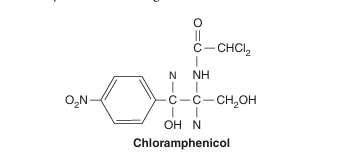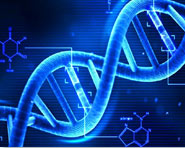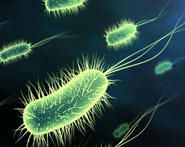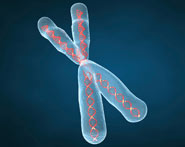


 النبات
النبات
 الحيوان
الحيوان
 الأحياء المجهرية
الأحياء المجهرية
 علم الأمراض
علم الأمراض
 التقانة الإحيائية
التقانة الإحيائية
 التقنية الحيوية المكروبية
التقنية الحيوية المكروبية
 التقنية الحياتية النانوية
التقنية الحياتية النانوية
 علم الأجنة
علم الأجنة
 الأحياء الجزيئي
الأحياء الجزيئي
 علم وظائف الأعضاء
علم وظائف الأعضاء
 الغدد
الغدد
 المضادات الحيوية
المضادات الحيوية|
Read More
Date: 2024-12-16
Date: 2025-01-06
Date: 23-3-2016
|
Chloramphenicol is a substance produced originally from cultures of Streptomyces venezuelae but is now manufactured synthetically.
Crystalline chloramphenicol is a stable compound that is rapidly absorbed from the gastrointestinal tract and widely distributed into tissues and body fluids, including the CNS and CSF; it penetrates cells well. Most of the drug is inactivated in the liver by conjugation with glucuronic acid or by reduction to inactive arylamines. Excretion is mainly in the urine, 90% in an inactive form. Although chloramphenicol is usually administered orally, the succinate can be injected intravenously in similar dosage..

Chloramphenicol is a potent inhibitor of protein synthesis in microorganisms. It blocks the attachment of amino acids to the nascent peptide chain on the 50S unit of ribosomes by interfering with the action of peptidyl transferase. Chloramphenicol is principally bacteriostatic, and its spectrum, dos- age, and blood levels are similar to those of the tetracyclines. Chloramphenicol has been used to treat many types of infection (eg, from salmonellae, meningococci, H influenzae), but it is no longer the drug of choice for any infection.
Chloramphenicol resistance is caused by destruction of the drug by an enzyme (chloramphenicol acetyltransferase) that is under plasmid control.
Chloramphenicol infrequently causes gastrointestinal upsets. However, administration of more than 3 g/day regularly induces disturbances in red blood cell maturation, elevation of serum iron, and anemia. These changes are reversible upon discontinuance of the drug. Very rarely, individuals exhibit an apparent idiosyncrasy to chloramphenicol and develop severe or fatal aplastic anemia that is distinct from the dose-related reversible effect described earlier. For these reasons, the use of chloramphenicol is generally restricted to infections in which it is clearly the most effective drug by laboratory test or experience.
In premature and newborn infants, chloramphenicol can induce collapse ("gray syndrome") because the normal mechanism of detoxification (glucuronide conjugation in the liver) is not yet developed.



|
|
|
|
التوتر والسرطان.. علماء يحذرون من "صلة خطيرة"
|
|
|
|
|
|
|
مرآة السيارة: مدى دقة عكسها للصورة الصحيحة
|
|
|
|
|
|
|
نحو شراكة وطنية متكاملة.. الأمين العام للعتبة الحسينية يبحث مع وكيل وزارة الخارجية آفاق التعاون المؤسسي
|
|
|